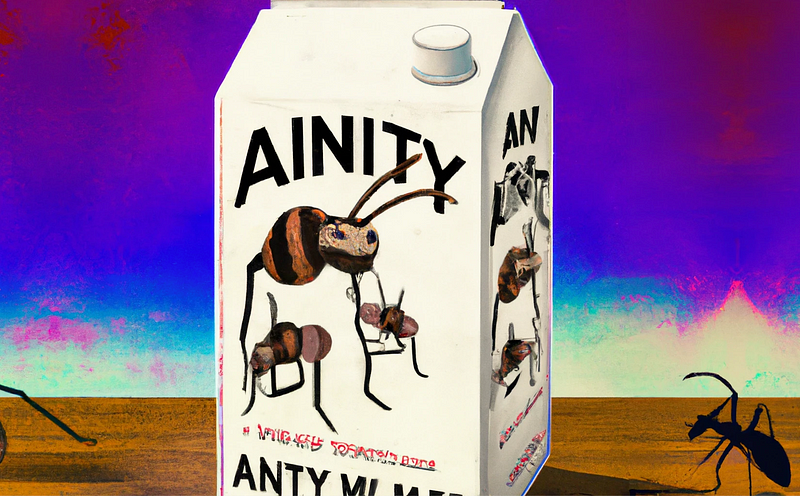Ant-Based Milk: The Surprising Discovery of Ants' Nutritional Secret
Written on
Chapter 1: The Rise of Plant-Based Alternatives
Having lived in The Netherlands for over a year and a half, I've been struck by the overwhelming popularity of plant-based milks here, surpassing even the trends seen in the U.S. Many cafes, known as coffee shops in a different context, typically offer four to five kinds of alternative milks.
This is particularly beneficial for those with dietary restrictions. For instance, my lactose-intolerant boyfriend was thrilled to order a chai latte without worrying about digestive issues. One café even made oat milk the default option, surprising my co-worker and me during our first visit when she found her cappuccino unexpectedly bitter—neither of us had noticed the small sign indicating their milk policy.
As a food scientist in this progressive Dutch town, I'm no longer surprised by the introduction of new nut, legume, or seed milks; it's just a regular occurrence. However, the recent discovery of ant-based milk truly caught my attention!

Chapter 2: Unveiling Ant-Based Milk
Recent research has revealed that certain ant species produce a nutritious, milk-like fluid. This groundbreaking study, published in Nature, marks the first documentation of ant pupae excreting a substance that larvae consume directly. The larvae often attach themselves to the pupae using their mouthparts to access this nourishing liquid.
If you need a quick refresher on the ant life cycle, here's a brief overview: ants progress through four life stages: eggs, larvae, pupae, and adults. Starting as tiny eggs, they hatch into dependent larvae that cannot move or feed themselves, relying entirely on adult ants for sustenance.
Previously viewed as inactive, the pupae stage has now revealed its crucial role—excreting this nutrient-rich liquid not just for the young but also for adult ants in the colony. This discovery highlights the pupae stage's significance in the overall nutrition and development of the colony.

Chapter 3: Nutritional Profile of Ant-Based Milk
It may seem far-fetched that ants produce something akin to "milk," but the fluid secreted by pupae shares remarkable similarities with cow's or human milk. Tests indicate that this ant fluid is highly nutritious, containing at least 185 unique proteins and over 100 metabolites, including amino acids, sugars, and vitamins.
Cow's milk, known for its rich nutrient content, typically includes 3.3 grams of protein per 100 mL, along with essential minerals like calcium and potassium. Likewise, the ant-based liquid is not just nutrient-dense; it also contains hormones and neuroactive compounds that support the larvae's growth and development.
This composition resembles human breast milk, which is lauded as the optimal source of nutrition for infants, packed with bioactive compounds that help build immunity and protect against infections. Just as infants thrive on breast milk, young ants that consume the pupae's fluid exhibit better growth and survival rates.

Chapter 4: Legal Perspectives on "Milk"
Now, let's analyze this from a legal standpoint. In the United States, drinks derived from seeds, nuts, and legumes are labeled as "milk," so it raises the question: why not ant milk? Interestingly, this practice contradicts the definition of milk outlined in the Code of Federal Regulations (CFR), which specifies that milk is the lacteal secretion from healthy cows.
However, this definition has been challenged, as seen in the case of Painter v. Blue Diamond, where judges ruled that consumers recognize almond milk as a distinct product. This judicial decision paved the way for plant-based beverages to be marketed as "milk," creating a discrepancy with the CFR's definition.
In contrast, the European Union has stricter regulations, requiring plant-based alternatives to be labeled as "drinks." Therefore, while ant-based milk could be marketed in the U.S., it would need to adhere to different standards in Europe.
The first video, The DOWNFALL of Plant-Based Milks, delves into the issues surrounding plant-based milk trends and their implications.
The second video, How to Make Plant Based Milk: EVERY WAY, explores various methods of creating plant-based milks.
Chapter 5: Future of Ant-Based Milk
Could ant-based milk be the next big thing in grocery stores? While it seems unlikely in the near future due to the limited quantity produced by each pupae, there are successful examples of insect-derived food products. For instance, carmine, a natural red pigment from beetles, is widely used in food products, highlighting how certain insect ingredients can be commercially viable.
Additionally, the growing interest in insect-based protein, celebrated for its sustainability and high-quality amino acid profile, suggests that there is potential for innovation in this area.
To move forward, researchers need to fully explore the nutritional profile of ant milk, as the current knowledge is based on a single study. Will it ever hit the market? Its commercialization would likely depend on discovering unique properties that could entice entrepreneurs to develop scalable production methods.
Feel free to share your thoughts and predictions about the future of ant-based milk!